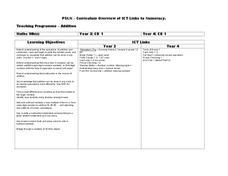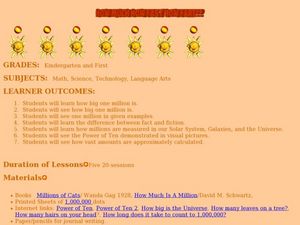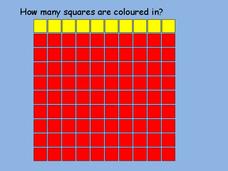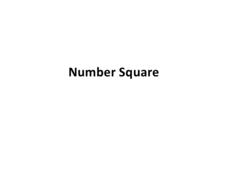Illustrative Mathematics
Assessing Sequencing Numbers
Assess whether your kindergartners can identify numbers in random order using two sets of numeral cards 1-10 and 11-20. Starting with a small group and the 1-10 deck give your learners the task of putting the cards into order from...
Curated OER
Counting Mat
Using the provided counting mats (1-6 and 7-12) and small objects to count with, guide your young learners to match the correct number of objects to the written numeral and dots. Class members will either read the numeral and count out...
Curated OER
Curriculum Links To Numeracy
Youngsters practice looking for the links to numeracy in their classes. This isn't a worksheet but a curriculum guide for an entire unit. Teachers can use any part of the resource to extend or inform their teaching practices related to...
Curated OER
How Much, How Fast, How Far?
Students investigate the concept of the number one million. In this number concepts lesson, students read the book How Much is a Million? and brainstorm questions, such as "how many leaves are on a tree" and "how many hairs are on your...
Curated OER
100 Or Bust!
Elementary schoolers use their understanding of place value to develop a strategy for a number game. In this activity, pupils use place value to play "100 or Bust" and figure out a good winning strategy. These kinds of math games are...
Curated OER
Skip Counting
Students practice the skill of skip counting. In this early math activity, students try counting at different rates, beinning at one and progressing to the number ten. Students create a number grid with Crayola Crayons.
Curated OER
Reading and Writing Numbers
Those are some long numbers! Scholars write number-form digits in word form and vice versa. The first eight are six-digit numbers and the next eight are seven-digit numbers. There are two examples to get them started. Remind scholars to...
Curated OER
Most and Least
Which one has the most? Each row has three sets of identical objects, and scholars compare the sets to determine which has the most or the least (they find the most for the first four and the least for the last four). One example is...
Curated OER
Expanded Form
Explore place value through re-writing these two-digit numbers in expanded form. For example, 47 becomes 40 + 7. There is one example to model this, and scholars complete 14 more on their own. Be sure they understand this process as...
Curated OER
Hopping by 2s
Hop to it! Young counters practice skip counting by two using illustrations of animals hopping from place to place. Each image shows a number sequence and scholars draw in the path as they move from number to number. Encourage them to...
Curated OER
Expanded Form
Practice place value through writing numbers in expanded form; scholars do this with numbers up to five digits. There are two examples to demonstrate the process, and the problems are split into four distinct sections to keep pupils...
Curated OER
Expanded Form
Writing numbers in expanded form is a great way to practice place value, and here scholars do this with numbers up to six digits. There are two examples to demonstrate the process, and scholars complete four distinct sections to keep...
MCAS Mentor
Number Sense and Operations
In this number sense and operations worksheet, learners solve 15 different types of problems that include reading number lines and solving inequalities. First, they write the scientific notation of various numbers given. Then, pupils...
Curated OER
Addition Grid
Which of these numbers add up to 20? Scholars find various addend pairs in a grid, circling those that add up to 20. There are many pairs they can find here, and the answer sheet offers some excellent kinesthetic practice ideas for...
Curated OER
Counting by 10s
You've got their attention once candy is the focus of a math learning exercise! Learners count by 10 to determine how many candies are in each set, which are all grouped by 10. There is an example and number line to help them, and they...
Curated OER
The Hundreds Place
Observe numbers in four different forms. Scholars become more familiar with place value as they match the numbers on the left with those on the right. The twist is that the numbers are shape-shifting! Some are in expanded form, others...
Curated OER
Multiplying Whole Numbers and Decimals
Upper elementary and middle school learners explore number sense by completing a list of multiplication problems in class. Learners discuss the difference between whole numbers and decimals while solving multiplication problems. They...
Curated OER
Tens and Units
Images of base ten blocks are used to reinforce counting past 10. Learners will count along, adding units to each 10 as they go from 10 to 30. Each number is shown on a 100 block, as blocks of 10s and 1s, and in numeric form as tens and...
Curated OER
Counting on a 100 Square
Counting by twos, fives, and tens is a great way to build the skills and number sense needed to better grasp the concept of multiplication later on. Here are six number charts to 100, each chart is highlighted and requires the class to...
Curated OER
Partitioning Numbers
Partitioning or decomposing double and triple-digit numbers is a wonderful way to build number sense and a basic understanding of place value. Here are 12 different numbers, partitioned into their base units and tens or hundreds...
Curated OER
Number Bonds to 20
Showcase all the different ways one can pair numbers, resulting in an answer of 20. Cute images such as, a cup and water, tennis racket and ball, and a soccer ball and net help kids make the addition connection. This is a great...
Curated OER
Number Bonds to 10: Game
Knowing number bonds that make 10 is a good way to build number sense and can help in solving basic addition and subtraction problems. Kids review number bonds, then play a game where they are given a number and try to shout out the...
Curated OER
Doubles and Halves 3
Build mental math skills by teaching learners to double and half three-digit numbers. They start out by doubling one of seven double-digit numbers. Next, they discuss their strategy, and then practice doubling and halving 3-digit...
Curated OER
Flash Fractions
The first few slides in this resource describe the parts of a fraction. Then, learners view various representations of a few given fractions. They complete an activity where they assess images to determine a specific part/whole...

























